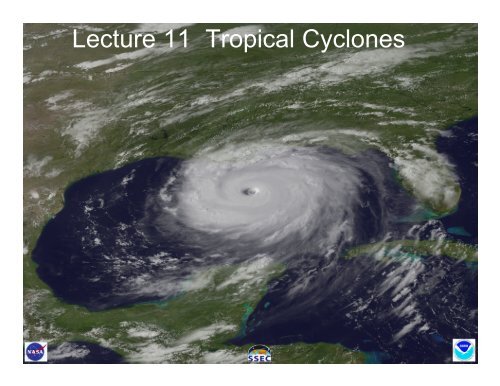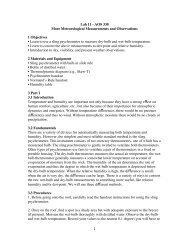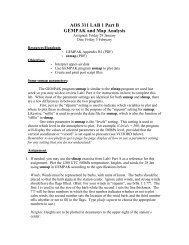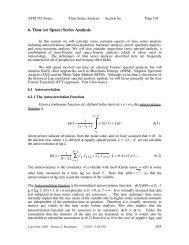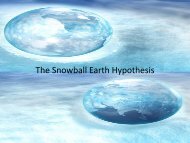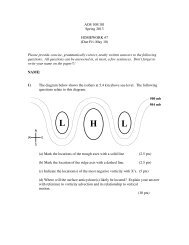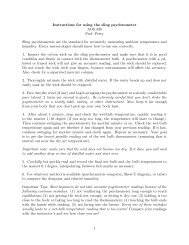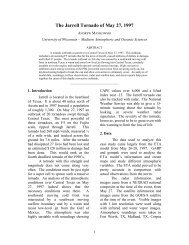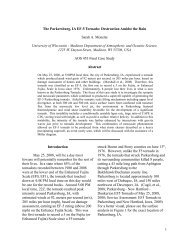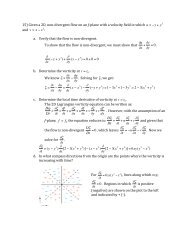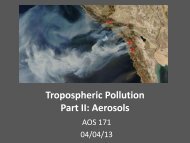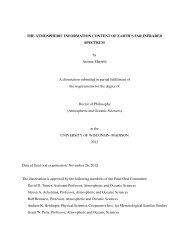Lecture 11 Tropical Cyclones - Atmospheric and Oceanic Sciences
Lecture 11 Tropical Cyclones - Atmospheric and Oceanic Sciences
Lecture 11 Tropical Cyclones - Atmospheric and Oceanic Sciences
- No tags were found...
Create successful ePaper yourself
Turn your PDF publications into a flip-book with our unique Google optimized e-Paper software.
<strong>Lecture</strong> <strong>11</strong> <strong>Tropical</strong> <strong>Cyclones</strong>
<strong>Tropical</strong> Cyclone• A cyclone that originates over the tropical ocean– Distinguished its “warm core”, i.e. the temperature in the centerof the tropical cyclone is relatively warm. In contrast, a middlelatitude or frontal cyclone is a “cold core” cyclone.– A mature TC can become extremely intense. We call a matureTC a:• "hurricane" (the North Atlantic Ocean, the Northeast Pacific Oceaneast of the dateline, or the South Pacific Ocean east of 160E)• "typhoon" (the Northwest Pacific Ocean west of the dateline)• "severe tropical cyclone" (the Southwest Pacific Ocean west of160E or Southeast Indian Ocean east of 90E)• "severe cyclonic storm" (the North Indian Ocean)• "tropical cyclone" (the Southwest Indian Ocean)
AtlanticHurricanesTyphoonsEastPacificHurricanesNorthern HemisphereSummer/Fall<strong>Cyclones</strong>Severe <strong>Tropical</strong>CycloneSouthern HemisphereSummer/FallSevere <strong>Tropical</strong>Cyclone
2004 Atlantic Hurricane Season
What role do TCs play in the<strong>Atmospheric</strong> <strong>and</strong> <strong>Oceanic</strong>Circulation?• They are a (desperate?) mechanism through which the atmospheretransfers heat from the ocean (extracted from excessively warm water) outto space. TCs tend to “boil off” excess energy stored in the oceans– Ocean circulations <strong>and</strong> evaporation from the surface naturally transport oceanheat into the atmosphere where air currents transport it further. The atmospherecontinually radiates energy to space cooling at 2 degrees/day on the average .– In the tropics these processes do not cool the ocean enough to prevent it fromreaching 27C which is conducive to the formation of TCs under certaincircumstances (low wind shear).– TCs dramatically enhance the heat transfer process <strong>and</strong> leave a cooled ocean intheir wake• Certain atmospheric flow patterns cool the ocean more than others, thusreducing the need for TCs– Sheared wind patterns produce stronger drying (therefore cooling) surface winds<strong>and</strong> also inhibit TC formation (this year, Atlantic) <strong>and</strong> vise versa (last year,Atlantic)– Weakening of warm transport by ocean currents, i.e. warm conveyor belt, can letexcess warmth build in the tropics favoring more frequent <strong>and</strong> stronger TCs (lastyear)– Deepening of warm water layer can increase fuel for TCs
Rappaportet al, NHC
Rappaportet al, NHC
Hurricane Tracks• Hurricanes are steered bythe mean lower troposphericflow• When the flow patternmoves, the storm can beforced to curve or even doloopsTypicalSubtropicalHighUnusual
Ritaeye
Ritahttp://cimss.ssec.wisc.edu/tropic/archive/2005/storms/rita/rita.htmleye
RitaSpiral b<strong>and</strong>seyeEye wallhttp://cimss.ssec.wisc.edu/tropic/archive/2005/storms/rita/rita.html
Eddy circulations in the eyehttp://cimss.ssec.wisc.edu/tropic/archive/2003/storms/isabel/isabel.html
Initiation of <strong>Tropical</strong> <strong>Cyclones</strong>• Atlantic (Hurricanes)– Easterly waves moving off of Africa– ITCZ distrubances– Frontal remnants from middle latitudes– Convective systems over US that move over the water• East Pacific (Hurricanes)– Easterly Waves from Africa moving across Isthmus– <strong>Tropical</strong> cyclones from Atlantic moving across Isthmus– Storms initiated in Venezuela mountains– Storms initiated by flow across Sierra Madre Mountains of CentralAmerica• West Pacific– ITCZ disturbances• initiated from westerly wind bursts along ITCZ– Easterly waves from Africa (rarely)
ITCZInitiation
• Troughs <strong>and</strong> ridges ineasterly flow are invertedcompared to troughs <strong>and</strong>ridges in westerly flow• Based in lowertroposphere– opposite to shortwave inthe westerlies which isbased in upper troposphere– Therefore, cloudiness isassociated withconvergence upstream ofthe trough which forces airupEasterly Wave500 mb850 mbridgetroughWesterly WaveridgetroughtroughEasterly Waveridge
Frontal Genesis
South Atlantic’s onlyHurricane(March, 2004)(frontal initiation)
Danny1997
PredictedMaximumIntensity
Classification of <strong>Tropical</strong> cyclones• 00 kts ≤ wind < 20 kts (23MPH)<strong>Tropical</strong> disturbance• 20 kts ≤ wind < 34 kts (39 MPH)<strong>Tropical</strong> depression• 34 kts ≤ wind < 64 kts (74 MPH)<strong>Tropical</strong> storm• 64 kts ≤ windHurricane
Saffir/Simpson Scale
Saffir/Simpson Scale
WISHE(Wind InducedSurface HeatExchange)


